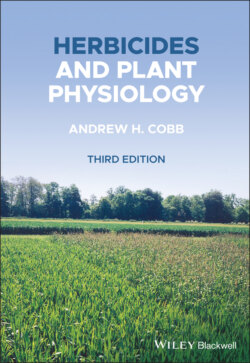Читать книгу Herbicides and Plant Physiology - Andrew H. Cobb - Страница 20
1.4.4 Weeds as reservoirs for pests and diseases
ОглавлениеWeeds, as examples of wild plants, form a part of a community of organisms in a given area. Consequently, they are food sources for some animals and are themselves susceptible to many pests and diseases. Because of their close association with crops, they may serve as important reservoirs or carriers of pests and pathogens, as exemplified in Table 1.6. Even where crop infestation does not occur, the presence of disease in weeds may cause problems, as is the case where grass weeds are infected with ergot (Claviceps purpurea), causing contamination of harvested grain with highly toxic ergot fragments.
Weeds may act as ‘green bridges’ for crop diseases, carrying the disease from one crop to another that is subsequently sown. Volunteer crops are particularly problematic in this case and can, in severe cases, negate the use of break crops as a cultural control measure for diseases. In addition, weeds can provide over‐wintering habitats for crop pests, resulting in quicker crop infestation in the spring. Ground cover provided by weeds can increase problems with slugs and with rodents, as the weeds provide greater cover and therefore reduced predation.
Table 1.6 Some examples of weeds as hosts for crop pests and diseases.
Source: Hill, T.A. (1977) The Biology of Weeds. London: Edward Arnold.
| Pathogen or pest | Weed | Crop | ||
|---|---|---|---|---|
| 1.Fungi | ||||
| Claviceps purpurea | (ergot) | Black‐grass | (Alopecurus myosuroides) | Wheat |
| Gaeumannomyces graminis | (take‐all) | Couch (Elytrigia repens) | Cereals | |
| Plasmodiophora brassicae | (clubroot) | Many crucifers | Brassicas | |
| 2.Viruses | ||||
| Tobacco ringspot | Dandelion | (Taraxacum officinale) | Tobacco | |
| Cucumber mosaic | Chickweed | (Stellaria media) | Many crops | |
| 3. Nematodes | ||||
| Ditylenchus dipsaci | (eelworm) | Chickweed | (Stellaria media) | Many crops |
| Spurrey | (Spergula arvensis) | |||
| 4. Insects | ||||
| Aphis fabae | (black bean aphid) | Fat hen | (Chenopodium album) | Broad and field beans |
In 1994 and 1995 there were several severe outbreaks of the disease brown rot in potato in several European countries, especially in The Netherlands, which was possibly exported to other countries via infected seed potatoes. This extremely virulent pathogen (Pseudomonas solanacearum, syn. Burkholderia solanacearum, syn. Ralstonia solanacearum) causes a vascular ring rot in the developing tuber and causes a major loss of yield. Although often considered a soil‐borne organism, it was not found to persist for long periods in the soil following the harvest of infected crops. However, it was found to survive in the aquatic roots of infected woody nightshade (Solanum dulcamara) growing at the edge of irrigation channels. Thus, it may be the case that the pathogen overwinters in this wild host and is leaching into watercourses used to irrigate the crop, thus spreading the disease. This perennial plant is now being eradicated from potato‐growing areas. Several other species could also act as alternative hosts to the pathogen, including Solanum nigrum and Tusilago farfara, but further work is needed to confirm this.
